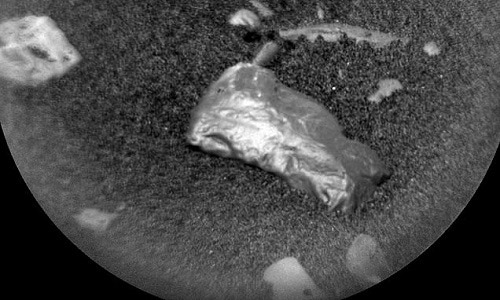NASA robot investigates strange shiny stone blocks on Mars
The Curiosity Mars exploration robot will learn the composition to determine the origin of the shiny stone different from the surrounding stones.

Little Colonsay stone blocks were discovered by NASA scientists in a photo.Photo: NASA.
NASA's Curiosity robot is investigating a strange rock with the official name "Little Colonsay" on Mars. Scientists discovered the stone in a wide picture and decided to send Curiosity to the location to look more closely, Independent yesterday reported.
"A specimen we are trying to look at in detail is the 'Little Colonsay' rock. The project team thought it might be a meteorite because the stone was too shiny. But the photo may be confusing, and the evidence is only from the chemical test results. Unfortunately, this small target missed out on the previous discovery and Curiosity will try again, " NASA said.
Operators will use ChemCam equipment on NASA's 6-wheel exploration robot to study rock mass. While looking at remote rock and surrounding soil, ChemCam will fire lasers and analyze the elemental composition of materials that can evaporate from points less than a millimeter on the surface of Mars. A spectrophotometer will provide details of minerals and microstructures in rock by measuring plasma, ultra-hot gases made from freely floating ions and electrons.
Curiosity cameras can resolve 5 - 10 times smaller objects than cameras on Mars Exploration Rover starting to explore the red planet in January 2004. Curiosity is operating at the top of Vera Rubin.
- NASA found the slab that could possibly contain life on Mars
- NASA discovered giant ice on Mars
- Discover the mysterious stone on Mars
- Discovered the Buddha statue on Mars
- Discover the largest ancient stone by humans
- Strange rock blocks like human heads, solid-bodied fish
- Strange shapes on Mars
- NASA explains strange images on Mars
- Robots can assemble themselves like in fiction
- NASA declares: Humans can live on Mars!
- NASA's bee bee exploration plan
- Revealed 'explorer' will go to Mars in 2020
 Van Allen's belt and evidence that the Apollo 11 mission to the Moon was myth
Van Allen's belt and evidence that the Apollo 11 mission to the Moon was myth The levels of civilization in the universe (Kardashev scale)
The levels of civilization in the universe (Kardashev scale) Today Mars, the sun and the Earth are aligned
Today Mars, the sun and the Earth are aligned The Amazon owner announced a secret plan to build a space base for thousands of people
The Amazon owner announced a secret plan to build a space base for thousands of people